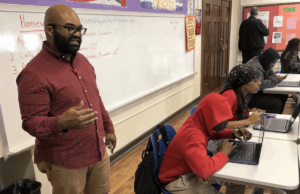The Shift to Digital: District, School, and Program Exemplars

This afternoon I moderated a Digital Learning Now session featuring three exemplars: Mooresville, KIPP Empower and Teach to One.
Middle school principal Carrie Tulbert kicked off the show for the Mooresville Graded School District, a great example of a district-wide 1:1 program using the same curriculum and laptop. With 5600 students, Mooresville is pretty representative in size and demographics—a slice of America. While their funding is near the bottom in North Carolina, their achievement and completion rates are near the top.
When I visited Mooresville a couple months ago I noted that It’s Not About the Machine, It’s About Heart. There is a strong culture of achievement and collaboration.
High School senior Troy Eckles noted all the ways that use of the laptop across the curriculum boosted his college preparation. Eighth grader Mark Miller noted the equity produced by giving every student the same level of access to digital learning.
“The digital conversion has resulted in a dramatic shift in my teaching,” said Samone Graham, a high school science teacher. Student publish rather than turn in and build a digital portfolio. Graham featured student video stressing the use of multimedia and humor to boost engagement and retention.
Mike Kerr, principal of KIPP Empower Academy featured their K-2 classroom rotation model that makes the most of their $5140 per pupil funding (about a third of the funding of his last post in NYC). KIPP Empower uses programs like ST Math to boost preparation and make time for small group instruction. Kerr tries to keep groups to 14 students during math and reading instruction. KIPP Empower is a blended learning model worth watching as the school grows to full enrollment.
Joel Rose, New Classrooms, described the Teach to One program which powers the NYC School of One as well as classrooms in Chicago in Washington DC. Teach to One is a middle school math program that uses an algorithm to recommend a sequence of lessons from a library of 10,000 tagged learning objects and to dynamically schedule eight different learning stations. The program makes sure that every student gets the right lesson on the right day in the right modality. It’s the best early example of customized learning and early results are promising.








Tom Vander Ark
I had breakfast with Eric Westendorf, LearnZillion (a LC co), and found out its widely used in Mooresville. Some of the LearnZillion CCSS aligned content will also show up in Teach to One.